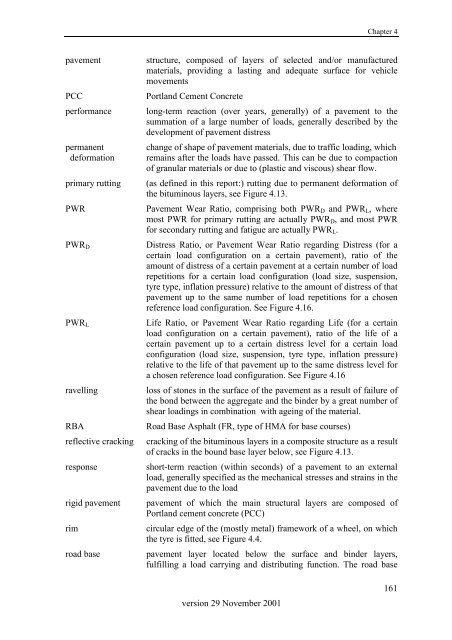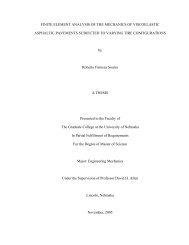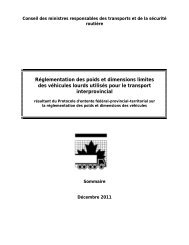You also want an ePaper? Increase the reach of your titles
YUMPU automatically turns print PDFs into web optimized ePapers that Google loves.
Chapter 4pavementPCCperformancepermanentdeformationprimary ruttingPWRPWR DPWR LravellingRBAreflective crackingresponserigid pavementrimroad basestructure, composed of layers of selected and/or manufacturedmaterials, providing a lasting and adequate surface for vehiclemovementsPortland Cement Concretelong-term reaction (over years, generally) of a pavement to thesummation of a large number of loads, generally described by thedevelopment of pavement distresschange of shape of pavement materials, due to traffic loading, whichremains after the loads have passed. This can be due to compactionof granular materials or due to (plastic and viscous) shear flow.(as defined in this report:) rutting due to permanent deformation ofthe bituminous layers, see Figure 4.13.Pavement Wear Ratio, comprising both PWR D and PWR L , wheremost PWR for primary rutting are actually PWR D , and most PWRfor secondary rutting and fatigue are actually PWR L .Distress Ratio, or Pavement Wear Ratio regarding Distress (for acertain load configuration on a certain pavement), ratio of theamount of distress of a certain pavement at a certain number of loadrepetitions for a certain load configuration (load size, suspension,tyre type, inflation pressure) relative to the amount of distress of thatpavement up to the same number of load repetitions for a chosenreference load configuration. See Figure 4.16.Life Ratio, or Pavement Wear Ratio regarding Life (for a certainload configuration on a certain pavement), ratio of the life of acertain pavement up to a certain distress level for a certain loadconfiguration (load size, suspension, tyre type, inflation pressure)relative to the life of that pavement up to the same distress level fora chosen reference load configuration. See Figure 4.16loss of stones in the surface of the pavement as a result of failure ofthe bond between the aggregate and the binder by a great number ofshear loadings in combination with ageing of the material.Road Base Asphalt (FR, type of HMA for base courses)cracking of the bituminous layers in a composite structure as a resultof cracks in the bound base layer below, see Figure 4.13.short-term reaction (within seconds) of a pavement to an externalload, generally specified as the mechanical stresses and strains in thepavement due to the loadpavement of which the main structural layers are composed ofPortland cement concrete (PCC)circular edge of the (mostly metal) framework of a wheel, on whichthe tyre is fitted, see Figure 4.4.pavement layer located below the surface and binder layers,fulfilling a load carrying and distributing function. The road baseversion 29 November 2001161






